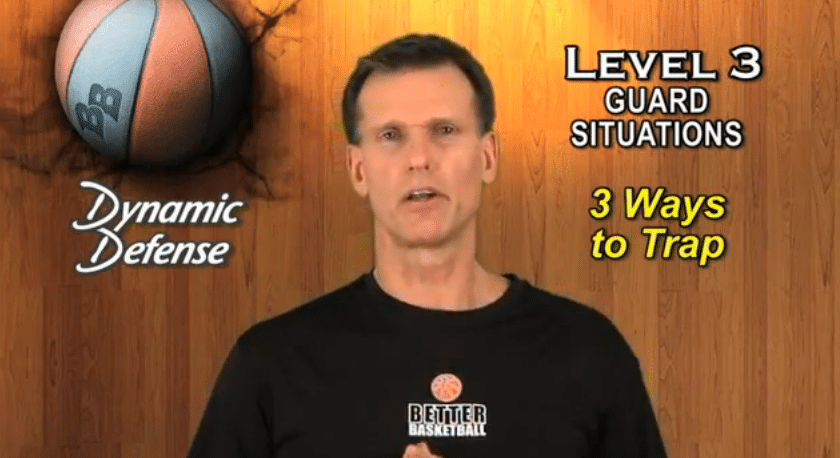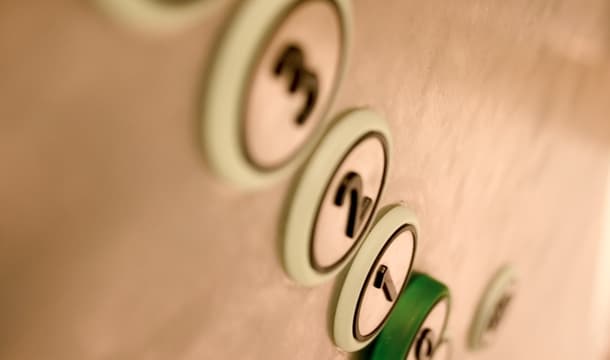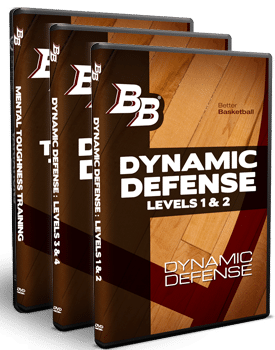13 Jun Take your basketball defense to the next level… literally
Here's what I mean. Within Dynamic Defense, there are four basic defensive levels for players to achieve. The first level requires you to be able to guard the ball and keep it out of the middle one-third of the floor. To achieve the second level, a player must not only guard the ball, but he or she must be able to defend away from the ball. That means being in a position to help a teammate keep the ball from being shot, driven, or passed into the middle one-third. A Level Three defender must be able to guard the ball, guard away from the ball and to also guard situations. What’s a situation? It’s an offensive action that has forced the defense to switch and rotate. You’ll know you’re about to define a situation when your players say, “Coach, what do we do in this situation?” The Level Four defender knows the best way for everyone to rotate out of a Level 3 situation, and get back to their original responsibilities, without giving up a basket. Now, what’s dynamic about those four levels?11 Jun Dynamic Defense Released… Finally!
I think Rick first teased the Dynamic Defense project three years ago at our Dallas Read & React Clinic. And, no, that was not a strategic announcement - our goal was not to build dramatic tension for three years. That's just how long it took...
08 Jun Dynamic Defense Level 0: Speed, Agility, & Quickness
At its core Dynamic Defense is a framework (and grading system) designed to push players to higher levels of defensive achievement. By moving across the four levels a player and her team will progress through guarding the basketball 1-on-1, helping effectively from any location, defending...
05 Jun Dynamic Defense Level 2: Basketball Close Outs
Athletically, I think the close out is one of the hardest techniques to master and even if you do, it’s hard to be consistent with it throughout a game (or even a possession). There are just so many details of a close out that favor...
28 May Dynamic Defense Level 1: Guarding the Basketball (And, the importance of grading)
Dynamic Defense is a leveled system for teaching individual and team basketball defense. It includes first a grading system so that players and coaches (and parents for a lot of you) can be on the same page as it relates to an individual's defensive development. Then, a curriculum for improvement within each level and also through the levels. Level 1 teaches what it means to Guard the Ball and then spends the rest of the time equipping the player with the skills to meet those requirements. Within Level 1, there are three grades of defenders: Great, Good, and OK. The following video is an excerpt from our new video package, Dynamic Defense. You can check out the breakdown of each video as well as the Dynamic Defense trailer here. http://www.youtube.com/watch?v=jeEDqymhfzQ Of course, we all want our players to be Great Level 1 defenders but that’s not always how it works out. It’s even possible (according to my definitions of Great, Good, and OK) to be a Great Level 1 defender when guarding Player X while being only a Good Level 1 defender when guarding Player Y. If you’re a Great Level 1 defender, you take away all three aspects of an offensive player's Triple Attack: The Shot, The Drive, and The Pass.24 May Dynamic Defense: How to Take a Charge
Every basketball coach wants their players to take charges, but let's face it, on just about every attempt to draw the charge it's a 50-50 chance that the call goes either way. With the speed of today's game, it's getting harder and harder for officials to determine (in a split second) what is and what isn't a charge. Ultimately, it comes down to what a ref thinks she sees and even then many times the reasons given for the call don't sound anything like what's in the rule book. When I saw Mano Watsa and Sefu Bernard teach this skill during one of their PGC Basketball camps, I knew I had to capture it for Dynamic Defense. Their teaching progression and drills were simply excellent! You’ll find two of their teaching points on this excerpt from Level 1 of Dynamic Defense.22 May Dynamic Defense: Interview with Dick Helm
Ever since we released the Read & React Offense a few years ago, coaches have been asking about the other side of the basketball coin - defense. Actually, they would ask, "So, what about a Read & React Defense?" And, for almost three years now, we've been teasing you about a leveled system of teaching defense. We're calling it Dynamic Defense instead of Read & React Defense, though. Actually, we never considered Read & React Defense because… well, because it didn't make sense. So, why Dynamic Defense?11 May 3 Commitments Every Successful Basketball Team Must Make
In a previous post, we mentioned the importance of visioneering and highlighted this quote by Antoine de Saint-Exupery:If you want to build a ship, don’t herd people together to collect wood and don’t assign them tasks and work, but rather teach them to long for the endless immensity of the sea.Every great endeavor begins with a vision of something greater than yourself, but until it's shared and internalized by the team, it will get no traction. So, as a coach, you are responsible to create (or at least mold) your team's vision. You are the captain of that ship after all.
 You can develop a successful vision for your basketball team by making three commitments:
You can develop a successful vision for your basketball team by making three commitments:
07 May Read & React Offense: How to Use Situations to Attack Competent Defenses
I define a "situation" as an offensive action that engages two or more defenders simultaneously. For example, most screening actions create situations, an attacking drive generates a situation, and many times just feeding a competent post player instigates a situation. If your opponent lacks cohesion as a defensive unit, a single situation may be enough to break them open for a score. The reality, though, is that most defensive teams are better coached and more prepared: they are capable of helping and recovering as well as double-teaming and rotating back without giving up a scoring opportunity. But, just because a team can handle one situation doesn't mean they can handle two or three in a row, or even two or three simultaneously.
Set this as a goal for your Read & React team (especially when you come up against better defensive teams): every possession, force the defense to handle more than one situation back to back or at the same time.
Below are a couple of examples of how you can do that.
But, just because a team can handle one situation doesn't mean they can handle two or three in a row, or even two or three simultaneously.
Set this as a goal for your Read & React team (especially when you come up against better defensive teams): every possession, force the defense to handle more than one situation back to back or at the same time.
Below are a couple of examples of how you can do that.





